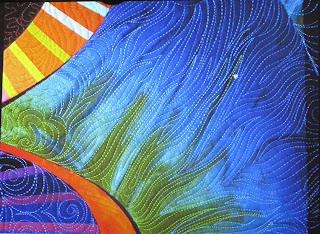 |
| Caryl Bryer Fallert-Gentry speaks to CQA members and guests. On the right is one of her pieces in progress. |
A large crowd of CQA members and guests were treated on July 13 to a highly professional, very inspiring program presented by Caryl Bryer Fallert-Gentry, now a part-time resident of the Pacific Northwest. An artist with an international reputation, Caryl is known for curvy, flowing, luminously colored works that have won her too many awards to count. Her pieces are to be found in museums and corporate and private collections all over the world.
After many years in the Chicago area, Caryl relocated to Paducah, KY ("Quilt City USA") in 2005. The following year she established Bryerpatch Studios, a large, two-story structure housing workrooms for classes and galleries in addition to her own private studio upstairs. (Married to Port Townsend, WA resident Dr. Ron Gentry earlier this year, she has now established "Bryerpatch West" in that city as well. This smaller studio is in use during the part of the year the couple spends in the Pacific Northwest.)
This scribe was so busy trying to absorb Caryl's wonderfully detailed, digital presentation that she wasn't able to write many notes, so this post will be fewer words, more pictures than usual! With luck, all the important information will be included in the captions.
 |
| View of the classroom at Bryerpatch Studios in Paducah |
|
|
 |
| Another view of the Paducah classroom |
 |
| Samples of Caryl's pieces as displayed at Bryerpatch Studios in Paducah |
In the early 1980s and for a number of years, Caryl dyed all of her fabrics, achieving glowing colors and subtle gradations. By the late 1980s she was also painting with dyes, manipulating wet fabrics and applying the dyes with squeeze bottles. She prefers 100% bleached cotton mercerized cloth for her dyeing. Starting in 2002, Benartex Fabrics began producing a line of fabrics based on her gradations, and she now uses a mix of those fabrics as well as her own hand-dyes.
 |
| (Above) "Squooshing" dyes onto wet fabric and manipulating it. (Top) A finished piece of Caryl's hand-dyed fabric. |
 |
| The Bryerpatch studios gives plenty of room for Caryl to quilt large pieces |
 |
| Pressing a large piece before trimming means using the floor |
 |
| Trimming is made easier by those specially selected, exactly 12" square, floor tiles! |
Caryl's machine quilting adds so much to the design and color of her quilts, as shown in the next three photos:
Her design process involves many steps, beginning with numerous small sketches...Caryl says she doodles whenever her hands aren't otherwise busy! Often she will continue to modify a single sketch until she has a number of related sketches that she can then build into a series.
 |
| A couple of sketches.... |
|
|
 |
| ...with various modifications, can turn into a potential series of pieces. |
Selecting a single sketch to develop further, Caryl will scan it, work out a gray-scale version to decide on values.
She then creates a line version of the design on a transparency, projects it--final size--and creates a freezer-paper pattern to provide templates for each element.
 |
| Registration marks are added so the pieces can be joined properly. |
 |
| Fabrics are selected and stitched to the templates. |
 |
| Caryl achieves a great deal of luminosity in the gradations of colors selected. |
 |
| Each piece is then trimmed... |
 |
| ...and placed in position on the "cartoon" on the design wall as the quilt begins to grow.... |
 |
| ...and grow! |
In joining the finished segments to each other, Caryl turns and glue-sticks the loose edges and attaches one piece to another with a narrow zig-zag stitch.
One of Caryl's newer series of quilts was inspired by feathers. Some of the designs are (relatively!) simplified, others much more complex.
 |
| Part of a simplified feather design, worked out on a computer. |
 |
| Portion of the simplified design. Note she chose less complex quilting for this type of design. |
 |
| Again, Caryl executes a series of sketches or variations of a design that can become a series. |
 |
| A finished piece in the feathers series |
Exquisite machine quilting provides the perfect finish:. Caryl uses microtex sharp needles, sizes 16 or 18, and 40-wt. polyester topstitch thread. She uses matching colors on both needle and bobbin threads. Rather than use variegated threads, she changes colors...a lot! Her batting is a Fairfield 50/50 bamboo and cotton; on her smaller pieces she will spray-baste the layers, using a repositionable product.
Some of her pieces (and series) can take their inspiration from nature, an example being the dried pods of this buttonweed plant.
 |
| She starts by scanning one of the little pods... |
 |
| ...to get an image to manipulate. |
 |
| With the image in gray scale, values can clearly be seen. |
 |
| With a lightbox, a line drawing is created on a transparency. |
 |
| The transparency is ready to project up to the finished size for the pattern to be created. |
 |
| A beautful, finished buttonweed seed pod! |
CQA is grateful to Caryl for bringing so many of her actual pieces to show her audience and for being so generous in showing her techniques...we are all inspired! For more information on Caryl, her works, and her classes and DVDs, see her website:
www.bryerpatch.com.




































Fantastic! Thanks for sharing.
ReplyDelete